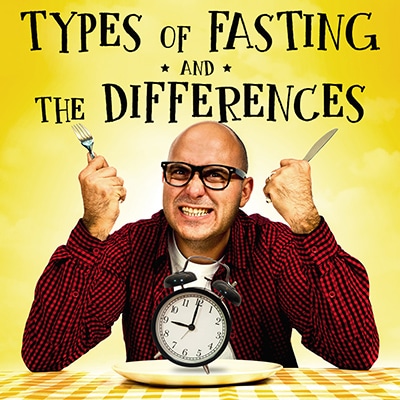Types of Fasting and the Differences
With the new year in full swing, many of you have made New Year’s resolutions.
One of the most common resolutions made is to become healthier in some shape or form.
Some want to exercise more, some want to stop eating junk food, others just want to make healthier lifestyle choices.
All of these are great!
In a recent article we published we talked about fasting and how good or bad it is for you.
This article focuses on each type of fasting, in case it is something you want to add to your New Year’s resolution of better health.
If you have decided to start fasting, please consult with your primary care physician first. This article is purely informational and not intended to diagnose or treat any disease or condition.
Why Should I Try Fasting?
While the studies are still being done, fasting has been shown to help with a great range of common illnesses and conditions.
If your New Year’s resolution was to become healthier, fasting can help supercharge the results of your resolution.
Early studies are saying that fasting seems to help with diabetes, high blood pressure, metabolic syndrome, and memory/learning capabilities.
Seems easy right?
Just don’t eat for a while and KABOOM!
Healthy as a horse! … Right?
Well not quite. It is important to stick with a specific fasting regimen.
There are a ton to choose from, and if one doesn’t work for you, you can always try a different one. The health benefits come from being consistent.
Ahhh! If I can’t stick to a diet, how am I going to stick to not eating?!
First, don’t quit before you’ve started.
There are ways to prepare yourself for fasting and are highly recommended to have consistent results and a more beneficial fast.
Certain fasts are easier to stick to since you don’t have to worry about what you are eating and those days are only once or twice a week.
The Importance of Picking a Fasting Regimen
Before getting into the types of fasting that you can choose from, you should choose a particular model to follow before beginning your fast.
The main reason for this is so that you find a fast the fits best with your lifestyle.
Believe it or not, this can make a HUGE impact on how successful your fast will be.
Some fasts are once or twice a week, while others more closely mimic a diet plan that goes on for longer periods of time.
With some fasts you can eat whatever you want during short periods of time, which is beneficial for people who enjoy having a social life and going out in the evenings.
If you feel that you absolutely CANNOT go without eating, then you should choose a fast that is more closely modeled to a diet.
Your goals from the fast will also help you determine what the best fasting type for you would be.
Some are better targeted for consistent weight loss while others are fantastic to help combat high blood pressure and pre-diabetes.
So before you choose your fast sit down and really think about what would best fit into your lifestyle. Consider your main goal and keep it in mind throughout the entire process.
If you are going to have a fasting partner, then work it out so you both can support each other and make the fast easier to manage.
Research shows that when you have a partner to keep yourself accountable, you have an easier time sticking to your goals!
Find yourself an F-buddy (fasting buddy) and get yourselves healthy!
Decisions, Decisions — What Fasting Type Best Suits You?
Are you excited? Are you nervous? Are you hungry??
More than likely just thinking about abstaining from food is making you hungry.
Do not fret, my friend! You can totally do this!
Below is your super guide to fasting. While there are a plethora of fasting types to choose from, the ones listed are the most researched and most common ones.
Best Fasting Types for a Busy Lifestyle
If you are always on the go and barely have time to sit down, then considering an Alternate-Day Fasting or 5:2 Fasting Regimen will work best for you.
Alternate-Day Fasting (ADF) & Alternate-Day Modified Fasting (ADMF)
- You will be eating whatever you want the first day. The next day you will not eat for anywhere from 12-24 hours.
- ADMF is when you set a cap amount of calories. Typically with this fast, you want your max to be between 200-500 calories but no more on your fasting days.
5:2 Fasting (Periodic Fasting)
- You eat as you want 5 days out of the week. The other 2 days you fast.
- It is your choice if you want to intake a few calories (especially when just starting out)
- If fasting every other day sounds like a bit too much, then this will be a better choice for you. Days that you will be busy are typically best to use as fasting days so you don’t focus on not being able to eat.
- Fasting days do not need to be consecutive.
Meal-Prepping Fasting Plans
If you are good at meal-prepping, these fasting plans will work out best for you. This allows you to still eat without becoming malnourished.
These are typically the best choices for women to help keep your hormone levels safe so you don’t risk becoming infertile.
Caloric Restriction (CR)
This one sounds the most like a diet, which makes it a little harder to stick with, but gives you the highest calorie limit.
- Caloric intake should gradually reduce to anywhere from 20-40% of your normal diet
- Stick with higher fat content foods to keep you fuller for longer
- Eat no processed foods and limit caffeine and sugar intake
- This has usually been suggested to those who are obese
- Eat foods that are high in nutrient content (bone broth is a fantastic choice) to avoid malnutrition
Time-Restricted Feeding
This also requires some important meal-prep but allows a little more wiggle room in what you eat.
-
- Allow yourself a window of time to eat between 4-8 hours long (some people push it to 12 hours, however, it is more beneficial for a shorter window of time)
- In this time frame, you should eat food throughout and not all at once
- Eat foods with the highest fat content closer to the end of the window to last you until you eat again the next day
- This also has been highly tested in obese patients and has worked out well for weight loss and helps battle metabolic syndrome (cardiovascular problems and diabetic issues)
Metabolic problems have less resolve in women than men with fasting of all types
The Daniel Fast
This regimen is based off of the fasting done for 21 days in the Biblical book Daniel. It is similar to CR but doesn’t restrict caloric intake as much, but focuses more on what you are allowed (or not allowed) to eat.
- Diet is restricted basically to a vegan style diet. You are allowed to eat legumes, fruits, vegetables, whole grains, nuts, and seeds.
- Put down the salted trail mix with flavors added! Preservatives are not allowed.
- This does require a good bit of meal prep, but it is the most inclusive fasting choice food wise.
- Eat whatever you want, whenever you want as long as it is in the list above.
- This is the most ideal for women so menstruation isn’t disrupted.
Top 9 Fasting Tips
- It is more mental than physical.
- Meal prep ahead of time and keep temptations out of sight (and mind)
- If you are getting super hungry and can’t take it anymore you should exercise. It helps to keep cravings and hunger pains at bay.
- Having an accountability partner makes it easier.
- It isn’t impossible.
- ALWAYS consult with your doctor before choosing to do a fasting regimen. Fasting can be dangerous.
- If you are incredibly sick from fasting or notice bad health changes you can stop. It isn’t for everybody.
- Plan your fasting days according to your schedule. Busiest days = less time to notice hunger.
- Taking a prebiotic like Atrantil can help keep your microbiome nourished and feeling good with the absence of food.
Keep these tips in mind when planning out your fast to ensure success.
Have you fasted before?
Do you have questions regarding fasting? Drop a comment below to express your thoughts! :)
For more on fasting watch our video below:


Atantril is best in a fasted state or after the meal?
Hi Sunny,
Thank you for your question. For best results we recommend taking Atrantil three times per day, with meals. We hope this helps to clarify.
Please let us know if we can be of further assistance.
Thank you and best wishes,
Team Atrantil